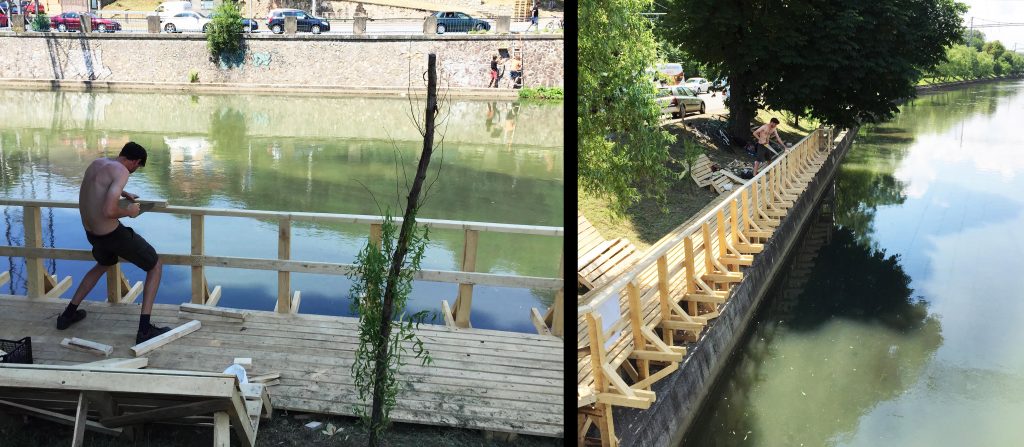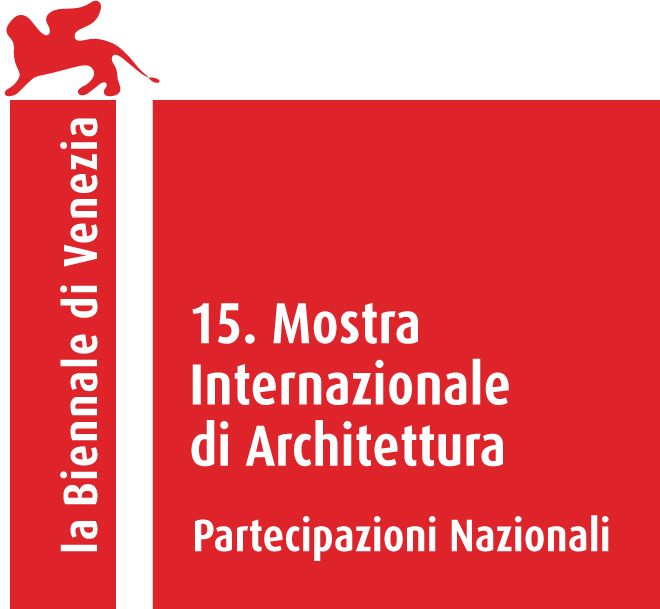It is impossible, within an arm’s length, to take a group selfie that is representative enough for architects in Romania – in case we would want to hang one in an exhibition relevant for national representation. Taking a selfie needs a little bit of self-love. We do narcissistically love ourselves, that’s not the issue, but individually or in small groups, by no means for something we might share all together. Moreover, we want to look special, while selfies have this curious effect of making us look more or less the same. So – paradoxically – random clichés might be more relevant for our architectural milieu than any staging of collective self-promotion.

In the attached photos (shot without warning), an architecture student works on an installation designed and built together with a team of colleagues, in the frame of a wider project of public space activation in a Romanian city. This site by the river would later be the stage of a battle between authorities and civic activists (don’t imagine billy clubs and smoke – it was a tense, but benign street dialogue). Activists were opposing authorities, who wanted a street enlargement to facilitate car traffic – and therefore sacrifice the riverside trees. Looking at various subsequent selfies, one may believe the activists won the battle. In reality, these images still reflect the present state of things: the battlefront remains open and the struggle for who decides what actually happens with the public space in our cities is carried out with the most basic means.
Urban activism is the most obviously expanded “front” in recent years’ Romania. A decade ago, such direct confrontations, well-articulated and effective, were far from being something usual and natural, as they are now. The way architects act in the urban space has also changed during the last decade. But the truth is that the front line doesn’t place architects on one side (the good) and the rest on the other (the evil). The front line lies in between the recalcitrant idealists and the system, between the people with a diffuse sense of the good and those on the side of the power – broadly speaking, because in fact there are several parallel front lines, more or less visible or obscure. And architects can be found in all camps.
To start with, there are the architects engaged in the very visible projects of public administrations or in collaboration with the powerful investors (and there is no point in distinguishing between the two, as the political and financial powers are natural allies). These are architects who sincerely believe that this is the way they can access major resources, which they could use to make a real difference. Indeed, access to resources means power. However, in Romania, power is often blind to the distinction between using and using up. Power not only uses the resources of urban space, leaving them there for the future, possibly amplified, but it uses them up, consuming them for circumstantial political and financial benefits. For instance, using green spaces for various architecture projects or for improving car traffic (in fact their definitive exhaustion, once and for all), as in the case above, is endorsed by the architects in power.
Then, there are other architects who are critical towards the power, but only because this does not involve them enough in its projects. They endorse their own position of power: the expert’s authority. From their point of view, architects’ well-being is automatically the well-being of the city; the distinction between doing good and doing well is softly erased. For instance, in a case such as the one above, these architects believe that only a professional study can decide what is best for the people – trees or car traffic – because people are not able to decide for themselves. The architectural expert discourse, corporatist and technocratic, dwells in the halo of power, in spite of overtly contesting it. It makes communication opaque, stressing the vertical distance between “us” (below) and “them” (above).
However, there are also more and more architects in Romania who would like to carry out the struggle in a (seemingly) common language. It is already a cliché that powerful actions can also come from those deprived of power, when they have a higher purpose – such as the public good. But if this is a cliché, it does not mean that it lost all meaning and became unimportant – among other reasons, because it reveals a distinction between power and elite worth highlighting. There is a deeply rooted preconception that a position of power automatically makes one superior. This is the current image in the selfies of those in power. In reality, the higher purpose of public good is what defines the “elite” (maybe also the fact that it usually doesn’t legitimate itself as such). Architects in the activist camp understand that architecture remains a high-level profession only as long as people recognize it as such, and because it did them good.
A doubt could emerge at this point. Does urban activism – benign but minor – deserve the central position in a selfie representing our architectural milieu? Is it relevant for the general state of struggle fought by the majority of architects in Romania? Maybe other priorities and hierarchies should have been more objectively made. Let’s not forget that, besides the architects enrolled in various battles for, against or at the margins of power, there is a large range of architects purely and simply opposed to any regimentation, who discretely work behind the front, in the most diverse and normal ways – that is, abiding to all the norms of a professional system that produces architecture. Many architects are either indifferent to the ephemeral agitations not directly concerning them, or maybe simply sympathetic with the right causes. For many, especially for those who lived under communism, the very notion of “activism” has suspicious connotations. And finally, let’s not forget those who engage – as the typical “impartial” Romanian – in opposed camps at the same time.
It is difficult to catch such a diverging landscape in one complete selfie. Therefore, let us present another kind of comprehensive image, an utterly objective, abstract and structured one, equitable and hierarchical at the same time: the statistical image. Being made by others, it may gain in credibility. We are referring to a study made by the Architects’ Council of Europe a couple of years ago, which places us in a larger context, allowing therefore an escape from the narcissistic illusions and a realistic assessment of our place among others.
The first observation is that, in many respects, Romanian architects don’t stand out in the European context; statistically, they are integrated. True, they are relatively few, much under the European average – not in absolute figures though, in proportion to the total population of the country. They match however the exact European average in terms of work supply for a full-time professional activity; in Romania, architects are neither more nor less unemployed than the usual European architect. They are also integrated in terms of education: the proportion of the architects in Romania who have at least in part studied abroad is slightly above the European average. The women/men ratio is not far from balanced, even a little better than in the rest of Europe.
Architects in Romania excel in youth: the proportion of those under 40 is much higher than the European average. However, there are areas where they are worse off: the rate of public commissions for example, or the recycling of architecture (the ratio between old building renovations and new buildings is one of the smallest in Europe). And finally the situation of incomes is rather bad: Romanian architects are almost the worst paid in Europe. But all is relative and they do well as architects within the context of the Romanian society: they still report higher levels of satisfaction than the average for having chosen this profession.
Statistically, we can already compose a cliché that is certainly representative. If the architectural milieu in Romania has something special, is that it is young and poor. It is, for that matter, similar to the Romanian society, which also is young and poor (young as a democratic system, not in terms of biological age of its citizens). We therefore have all the required conditions for an architectural milieu strongly involved in civic activism: many young architects, a democracy that is still young and lots of social problems.
Looking closer to the statistical figures, another specific reality stands out: a bottleneck in the age pyramid. The 40-55 generation is relatively thin, reflecting the low number of architects produced by the Romanian school in the last communist decade and the first years after 1989. Our professional milieu comprises two major age cohorts: architects under 40 and above 55. There is therefore a pretty large distance between generations. Moreover, the remarkable unity in the professional training of the older generation (with the 6-year diploma obtained on the same standards and only from the Ion Mincu architecture school in Bucharest) is now superseded by many centrifugal directions – architects under 40 have graduated from other Romanian schools too, with many having at least partially studied abroad.
The large number of Romanian architecture school graduates and the heterogeneity of their training have determined a real turning point in the last years. What has recently occurred was that this new generation reached the critical mass in the Romanian architectural milieu. The ways of understanding architectural practice have multiplied beyond the existing system’s encompassing capacity, metamorphosing the already fluid identities.
But if the new generations began to impose themselves simply by numbers, it does not mean they also do so in terms of power – that is, through their access to resources. They have arrived at a banquet table where most of the good seats are already taken. The system they recently penetrated is too narrow and too conventionally staged. By the nature of things, these generations will be inclined, or even vitally compelled, to explore in most divergent directions, pushing the system to its edges.
Finally, the “mechanism” comes here in sight. It is not sophisticated, but outright elementary. Like evolution and natural selection, it is unstoppable. That does not mean it is predictable. It has no script or any kind of predetermined instructions, and no direction guaranteed. What does this mechanism consist of? It is the fact that once reached, the critical mass triggers the machinic effects of a force field, defined by the desires and illusions of the new generations, who can thus penetrate the system with the force of a natural phenomenon.
However, from here on, the mechanism cannot produce anything by itself. For beyond the effects of immediate change, a generalized battle front cannot ever build something. It is not the mass effect that can do the fine-tuning adjustments of the system. It is only by precise actions, preferably true rather than successful, that the system would be able to evolve and adapt according to the desires of the new generations.
This is why the image we started with remains still relevant. Here, at the margins and at small scale, it is most obvious what keeps the mechanism of change going – no matter how objective and unstoppable. The sources of energy which make it work, now as ever, are only the individual passions.
